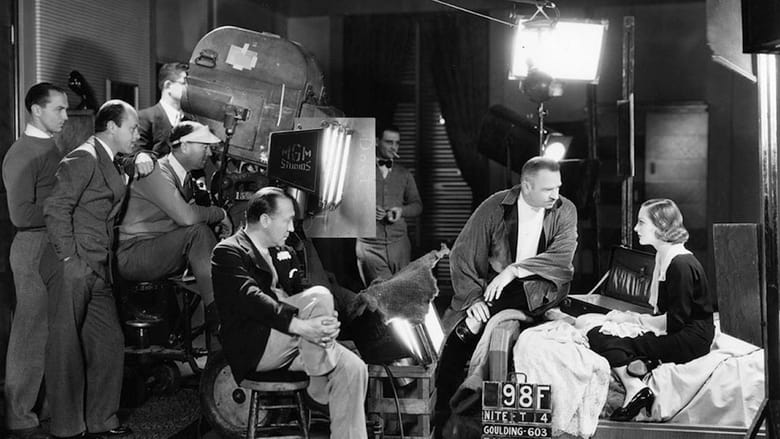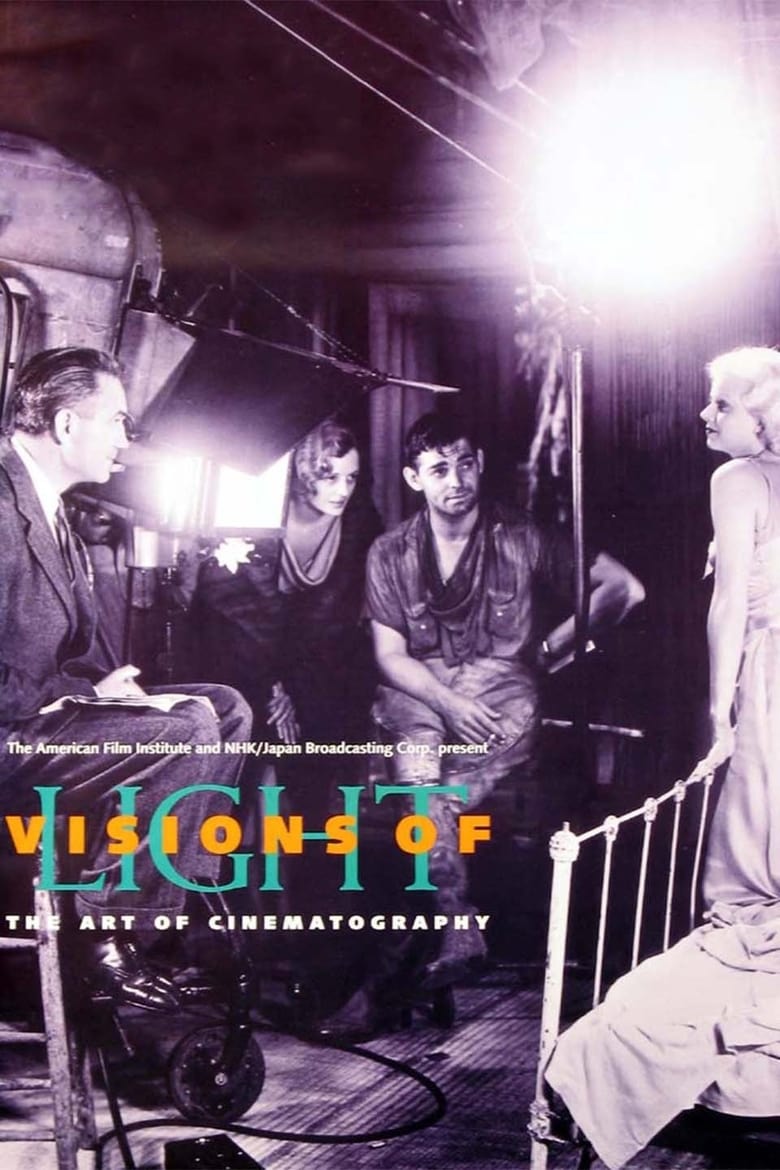Loading


Visions of Light
The Art of Cinematography
Genres
DocumentaryHistory
Overview
Cameramen and women discuss the craft and art of cinematography and of the "DP" (the director of photography), illustrating their points with clips from 100 films, from Birth of a Nation to Do the Right Thing. Themes: the DP tells people where to look; changes in movies (the arrival of sound, color, and wide screens) required creative responses from DPs; and, these artisans constantly invent new equipment and try new things, with wonderful results. The narration takes us through the identifiable studio styles of the 30s, the emergence of noir, the New York look, and the impact of Europeans. Citizen Kane, The Conformist, and Gordon Willis get special attention.
Details
Budget
$0
Revenue
$0
Runtime
92 min
Release Date
1992-09-17
Status
Released
Original Language
English
Vote Count
48
Vote Average
7
Cast
Meet the talented actors who bring the movie to life.
Ernest R. Dickerson
Self
Michael Chapman
Self
Allen Daviau
Self
Caleb Deschanel
Self
Lisa Rinzler
Self
Conrad L. Hall
Self
William A. Fraker
Self
John Bailey
Self
Néstor Almendros
Self
Charles Rosher Jr.
Self
Vilmos Zsigmond
Self
Stephen H. Burum
Self
Harry L. Wolf
Self
Charles Lang
Self
Sven Nykvist
Self
Robert Wise
Self
László Kovács
Self
James Wong Howe
Self (archive footage)
Haskell Wexler
Self
Vittorio Storaro
Self
John A. Alonzo
Self
Victor J. Kemper
Self
Owen Roizman
Self
Gordon Willis
Self
Bill Butler
Self
Michael Ballhaus
Self
Frederick Elmes
Self
Sandi Sissel
Self
Todd McCarthy
Self (uncredited)
Similar Movies
Explore movies similar to this one that you might also enjoy.
8.0
Gina Carano in Training
2012-05-01 | en
0.0
Citizen B
Documentary on Ciby 2000, the French film production company founded by Francis Bouygues in 1990.
2025-01-17 | fr
0.0
On the Trail of Ed Wood
A documentary on the life and career of filmmaker Edward D. Wood Jr., with clips from his films and interviews with the cast and crews of some of his films.
1990-01-01 | en
5.5
The Road To Ironman
The Road To Ironman follows Mauritz Eklund's inspiring journey as he prepares for an Ironman 70.3 triathlon. Throughout the series, Mauritz shares his motivations, training regimen, and the physical and mental challenges he faces. Each episode offers a glimpse into the dedication and perseverance required to achieve this monumental goal, capturing the highs and lows of his preparation. From intense workouts to moments of self-reflection, the series provides an authentic and motivating look at what it takes to become an Ironman.
| en
7.8
Zombies in the Sugar Cane Field: The Documentary
Tucumán, Argentina, 1965. Three years before George A. Romero's Night of the Living Dead was released, director Ofelio Linares Montt shot Zombies in the Sugar Cane Field, which turned out to be both a horror film and a political statement. It was a success in the US, but could not be shown in Argentina due to Juan Carlos Onganía's dictatorship, and was eventually lost. Writer and researcher Luciano Saracino embarks on the search for the origins of this cursed work.
2019-11-08 | es
0.0
Censored!
A documentary about the cultural effect of film censorship, focusing on the tumultuous times of the teens and early 1920s in America.
1999-12-31 | en
0.0
Somewhere Between New York and LA
Since he was 18 years old, Blake Eckard has written and directed six feature length films in his hometown of Stanberry, Missouri (population 1186). Aside from a short distribution deal in Canada and a few festival screenings, his movies have largely gone unseen.
2020-11-08 | en
4.0
At the Coliseum Deluxe
A feature length documentary about Australian popular entertainment across 150 years; of Skating and Dancing, Vaudeville and Moving Pictures.
2019-11-03 | en
0.0
Hitlers Traum von Micky Maus - Zeichentrick unterm Hakenkreuz
The order comes in the summer of 1941 from propaganda minister Joseph Goebbels himself: The best animators are summoned to Berlin. Their task: Producing feature-length cartoons in ‘Disney-Quality’ with the newly founded ‘Deutsche Zeichenfilm GmbH’. To get trained, the Disney movie “Snow White” is re-traced frame by frame. After the final victory, one new feature-length production of quality shall be released every year from 1947 onwards. – that is the plan. Only in 1943, the first production is completed: “Armer Hansi” a 17-minute-long colour movie, realized with the effortful Multiplane-technology. The second film by the ‘Deutsche Zeichenfilm’ is only completed in 1946 – by DEFA. In the territories occupied by Germany, cartoons are produced as well, sometimes harmless ones, sometimes propagandistic ones. With excerpts from animated movies, life-action film documents, and witness reports by contemporaries, this documentary draws a picture of the cartoon production in the third Reich.
1999-01-01 | de
8.0
Wuthering Heights: Love, Hate and Vengeance
In 1847, British writer Emily Brontë (1818-48), perhaps the most enigmatic of the three Brontë sisters, published her novel Wuthering Heights, a dark romance set in the desolation of the moors, a unique work of early Victorian literature that stunned contemporary critics.
2022-11-09 | fr
6.2
Hollywood Bulldogs: The Rise and Falls of the Great British Stuntman
They created and performed the iconic action sequences of 007, Indiana Jones, Superman, Rambo, Star Wars, Conan, the Alien films and pretty much everything since. They crashed cars, jumped from burning buildings, shot, stabbed, kicked and punched their way into cinema history. This is the first feature documentary to unite the legendary community of stuntmen in telling their story and, as you'll see, there's life in the old dogs yet.
2021-06-24 | en
0.0
Major Grom: Plague Doctor. Behind the Scenes
Additional materials for "Major Grom: Plague Doctor" (2021).
2022-11-03 | ru
7.3
The Rebellious Olivia de Havilland
The legendary British-American actress Olivia de Havilland (1916-2020), who conquered Hollywood in the thirties, challenged the film industry when, in 1943, she took on the all-powerful producer Jack Warner in court, forever changing the ruthless working conditions that restricted the essential rights and freedom of artists.
2021-07-02 | fr
10.0
Cartoons Go To War
This remarkable documentary dedicates itself to an extraordinary chapter of the second World War – the psychological warfare of the USA. America’s trusted cartoon darlings from the studios of Warner Bros., Paramount, and the “big animals” of the Disney family were supposed to give courage to the people at the homefront, to educate them, but also to simultaneously entertain them. Out of this mixture grew a genre of its own kind – political cartoons. Insightful Interviews with the animators and producers from back then elucidate in an amusing and astonishing way under which bizarre circumstances these films partially came into existence.
1996-04-26 | en
7.9
To Hell and Back: The Kane Hodder Story
To Hell and Back: The Kane Hodder Story is the harrowing story of a stuntman overcoming a dehumanizing childhood filled with torment and bullying in Sparks, Nevada. After surviving a near-death burn accident, he worked his way up through Hollywood, leading to his ultimate rise as Jason Voorhees in the Friday the 13th series and making countless moviegoers forever terrified of hockey masks and summer camp. Featuring interviews with cinema legends, including Bruce Campbell (Ash vs. Evil Dead), Robert Englund (Freddy Krueger), and Cassandra Peterson (Elvira: Mistress of the Dark), To Hell and Back peels off the mask of Kane Hodder, cinema's most prolific killer, in a gut-wrenching, but inspiring, documentary. After decades of watching Kane Hodder on screen, get ready to meet the man behind the mask in To Hell and Back - an uniquely human story about one of cinema's most vicious monsters.
2017-08-26 | en
4.6
Nice Girls Don't Stay for Breakfast
In the late 1990s, iconic photographer Bruce Weber barely managed to convince legendary actor Robert Mitchum (1917-97) to let himself be filmed simply hanging out with friends, telling anecdotes from his life and recording jazz standards.
2019-02-27 | en
0.0
Constructing Reality: A Film on Film
An exploration of the intricate art of filmmaking, delving into the multifaceted stages of scriptwriting, cinematography, and meticulous final editing. It provides a behind-the-scenes journey, unraveling the creative and technical complexities that bring a film to life. As an illustration, the film-within-a-film narrative centers around a race car competition.
1973-07-01 | en
6.0
Jacques Villeret, drôlement tragique
2025-01-28 | fr
6.1
A Cock and Bull Story
Steve Coogan, an arrogant actor with low self-esteem and a complicated love life, is playing the eponymous role in an adaptation of "The Life and Opinions of Tristram Shandy, Gentleman" being filmed at a stately home. He constantly spars with actor Rob Brydon, who is playing Uncle Toby and believes his role to be of equal importance to Coogan's.
2005-07-17 | en
6.0
Keiko Kishi, Eternally Rebellious
Born in 1932, Keiko Kishi has been one of the first Japanese actresses known worldwide. Her decision to move to France and to marry director Yves Ciampi in 1957 – after he filmed her in Typhoon Over Nagasaki starring Jean Marais and Danielle Darrieux – caused a huge scandal in Japan. Despite this transgression, Keiko Kishi continued acting in her home country with Kon Ichikawa, Yasujiro Ozu, Masaki Kobayashi… building unique bridges between Japanese and European cultures. Free and rebellious, she emancipated herself from the many obstacles she encountered in the film industry, and created her own production company in her early twenties. Let’s look back at the story of a pioneer, an inspiration for many generations.
2023-10-16 | fr